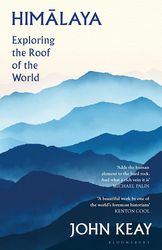The pandemic may have stopped John Keay from travelling. But it could not keep the popular historian and author from exploring. At 81, Keay chose to get to know the Himalayas, in his words “the bruised area’’ in the map of Asia, without leaving his chair. Himalaya is a breathtaking journey into the history, culture, ecology, archaeology and environment of the region.
Like the Indian American author Shahid Ali, known for his book, The Half-inch Himalayas, Keay, too, fell in love with the mighty mountains after a trip to Kashmir. He spent six months there in the 1960s. “I have never been interested in any climbing. I was much more interested in exploring the cultural and natural wonders,’’ says Keay. “It is quite a unique eco zone. I have tried comparisons with Antarctica where great care has been taken to preserve the environment and international agreements have been signed. But compare that with the Himalayas. It is our only high altitude ecosystem. And yet, it has been carved up and invaded throughout history and is now badly in need of serious conservation.’’
This passionate, well-argued plea is at the heart of the book. Keay begins with the 1904 expedition by Francis Younghusband which was the turning point in the history of the Himalayas. “The Younghusband expedition was really an incursion or an invasion,’’ says Keay. “This is one big event in the history of the Himalayas which changed the world’s perception of this region.’’
Being the first foreign expedition to reach Lhasa, the Younghusband campaign had major political implications. With the raging rivalry between Britain and Russia, it was seen very much a part of the ‘great game’. Keay, in his book, shares details about the cutthroat nature of reporters covering the expedition. “It is reckoned eight days from Darjeeling to Chumbi, but riding all day and most of the night, I completed the journey in two,’’ says Daily Mail correspondent Edmund Candler, explaining his attempt to pip his rival from the Times.
Filled with such details, Keay’s Himalaya is a deep dive into this magical, mystical and mysterious world. He brings alive several characters, like Swami Jnanananda Maharaj, FRGS, who was a “semi-resident’’ in Manasarovar for 23 years, and said to be the undisputed authority on the region. “But he was not born to the mountains, nor did he die among them. He was just called to them,’’ writes Keay. Or Hugh Falconer who hunted for fossilised fauna. There is also a glimpse of the maverick Raja Fateh Prakash Dirmoor who presented dignitaries with fossilised bones.
More than anything else, the book is a reminder that the Himalayas host a fragile ecosystem. Keay writes of an earthquake in August 1950, recording 8.6 on the Richter scale, which shook Calcutta and devastated Assam. In Lhasa, the Dalai Lama believed it to be an “ill omen’’. Many decades later, the threat of earthquakes remains as China continues to build enormous dams to tap the region’s hydroelectric potential. “The Chinese are planning a dam in the far southeastern Tibet, which will be about three times the size of the Three Gorges Dam, and produce about three times as much electricity,” notes Keay. “This will have a terrible effect on Tibet, which is the most probably the most precious and vulnerable environment in the whole region.’’
This is a book that is meant to be savoured, not to be conquered. Enjoy the ride.
HIMALAYA: EXPLORING THE ROOF OF THE WORLD
By John Keay
Published by Bloomsbury India
Price Rs503; pages 432


